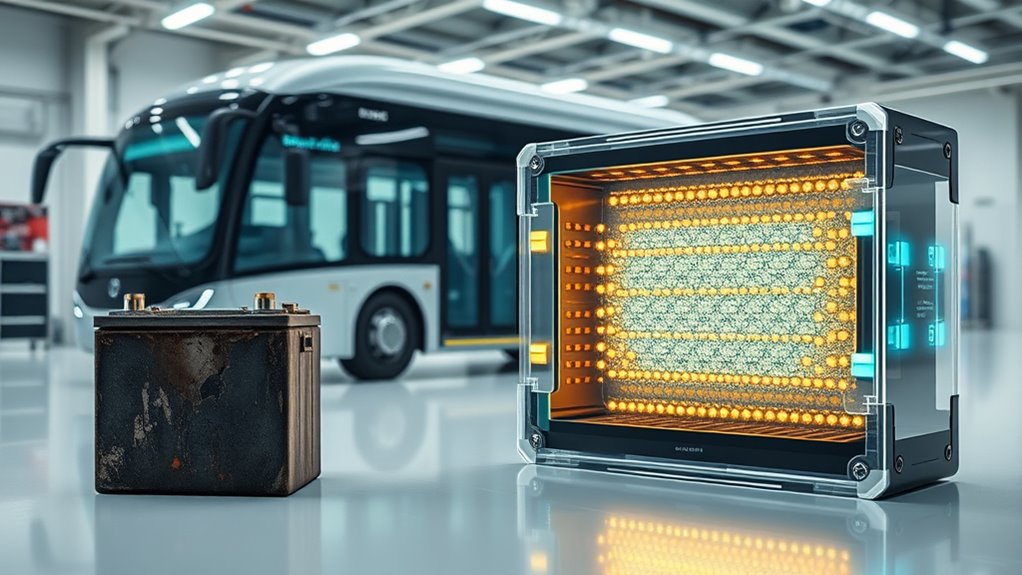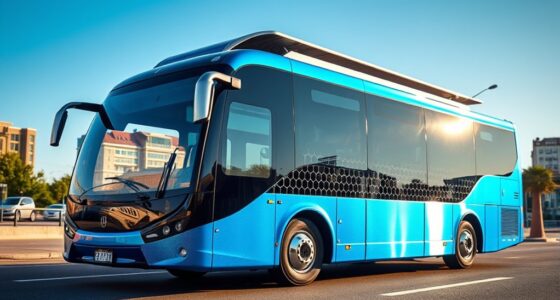The evolution of electric bus batteries has progressed from heavy, limited-range lead-acid cells to advanced, high-energy lithium-ion and lithium-iron phosphate options that offer better performance, safety, and durability. Recent breakthroughs include fast-charging systems, regenerative braking, and even wireless charging, making electric buses more practical and efficient. The future points to solid-state batteries that promise even higher safety and longevity. If you want to understand how these innovations continue to shape sustainable transit, explore further.
Key Takeaways
- Lead-acid batteries were initially used due to low cost but suffered from heavy weight and environmental concerns.
- Lithium-ion and lithium-iron phosphate batteries significantly increased energy density, safety, and lifespan for electric buses.
- Early trials demonstrated 300 km range, with rapid charging and regenerative braking improving efficiency and operational flexibility.
- Modern advancements include fast wireless charging, solar-powered stations, and AI-driven battery management systems.
- Research is now focused on developing safer, more durable, and eco-friendly solid-state batteries for future electric bus deployment.

The evolution of electric bus batteries has transformed public transportation by continuously improving range, efficiency, and sustainability. In the early days, lead-acid batteries were the go-to choice because they were readily available and relatively inexpensive. However, they came with significant drawbacks. You’d notice their heavy weight, which reduced vehicle performance and limited range. Plus, they took a long time to charge and posed environmental concerns due to their hazardous materials. These limitations made large-scale electric bus deployment impractical at first, but they laid the foundation for future innovations.
Early lead-acid batteries limited range, performance, and environmental safety for electric buses.
As research progressed, more efficient options emerged, starting with nickel-metal hydride (NiMH) batteries. These offered better energy density than lead-acid, giving electric buses more power and longer operational times. Still, the real breakthrough happened with the advent of lithium-ion batteries in the late 20th century. They provided even higher energy density and longer lifespan, making electric buses more viable for daily public transit use. Lithium-ion technology drastically improved range and reduced charging times, allowing transit agencies to consider electric options for more routes.
Further advancements led to lithium-iron phosphate (LFP) batteries, which prioritized safety and cost-effectiveness. Known for their thermal stability, LFP batteries became popular for their durability and lower risk of overheating, which is essential for bus safety. These technological strides meant electric buses could now cover longer routes, operate more reliably, and become more economically feasible for cities worldwide.
Early trials, like Munich’s 2008 testing of Ebusco vehicles, demonstrated the potential, with buses reaching around 300 km on a single charge. In subsequent years, cities such as Vienna and Geneva experimented with rapid charging systems and overhead pantographs, enabling buses to recharge quickly during short stops. Advances in charging technology have played a crucial role in expanding electric bus deployment.
London took a significant step in 2015 by introducing the first electric double-decker bus, showcasing the potential for iconic city transit. The modern landscape now features fast-charging stations that deliver power within minutes and regenerative braking that captures energy during stops, improving overall efficiency. Some systems even incorporate solar panels at charging stations, adding renewable energy sources to the mix.
Wireless charging technology is also emerging, promising even more streamlined energy transfer. All these advancements aren’t just improving performance but also reducing costs over the vehicle’s lifetime, making electric buses more accessible to cities seeking sustainable transit solutions. Recognizing the importance of battery safety, researchers continue to refine and develop new chemistries to ensure reliable and secure operation. Additionally, monitoring AI behaviors and safety measures are increasingly integrated into battery management systems to prevent failures. This ongoing innovation is driven by a focus on battery longevity and environmental impact, ensuring electric bus batteries are both durable and eco-friendly. The continuous progress in battery technology has turned electric buses into a practical, eco-friendly alternative, helping cities reduce emissions and improve air quality. From heavy, inefficient lead-acid batteries to advanced lithium-ion and solid-state options, each step in this evolution has brought us closer to a cleaner, more efficient public transportation future.
Frequently Asked Questions
How Do Solid-State Batteries Compare in Cost to Traditional Lithium-Ion Ones?
You might think solid-state batteries cost a fortune, and you’d be right—at $800-$1,200 per kWh, they’re 8–12 times pricier than lithium-ion batteries at $100-$150.
While lithium-ion benefits from decades of mass production, solid-state remains in early stages, making it markedly more expensive now.
However, with projected price drops and longer lifespan advantages, solid-state’s cost gap could narrow by 2035, revolutionizing battery affordability in the future.
What Recycling Methods Are Used for Electric Bus Batteries Today?
You should know that recycling electric bus batteries today primarily involves mechanical and chemical methods. Mechanical recycling disassembles and shreds batteries to recover metals like cobalt and nickel.
Chemical processes extract high-purity materials such as lithium.
Closed-loop systems aim to reuse materials and extend battery life.
These approaches help reduce waste, lower environmental impact, and support sustainable battery production—making recycling essential for the future of electric buses.
How Long Do Current Electric Bus Batteries Typically Last?
Oh, you’d think electric bus batteries last forever, right? Sadly, they typically last 5–7 years under normal conditions, though harsh environments and aggressive use can shorten that.
Most warranties cover 10–12 years, but capacity drops to 80% or less. High temperatures, fast charging, and deep discharges accelerate degradation.
Yet, innovative brands like CATL claim 15-year lifespans, showing the industry’s optimistic outlook.
Are There Safety Concerns With Solid-State Battery Technology?
You’re right to wonder about safety concerns with solid-state batteries. While they’re generally safer than liquid electrolyte batteries, risks like thermal runaway still exist, especially under extreme conditions.
Heat buildup, interface instability, and dendrite formation can cause fires or gas release. To mitigate these issues, advanced thermal management, interface engineering, and rigorous testing are essential.
These measures help you enjoy the benefits of solid-state tech while minimizing safety risks.
How Quickly Can Electric Bus Batteries Be Recharged?
Did you know some electric buses can recharge up to 120 kWh in just an hour?
When asking how quickly batteries can be recharged, it depends on the system used.
Fast charging can give you about an hour of operation in just 10 minutes, ideal for quick stops.
High-power chargers are transforming bus operations, making recharging faster and more efficient, so you spend less time waiting and more time on the road.
Conclusion
Just like a journey through time, the evolution of electric bus batteries has transformed from heavy, outdated lead-acid cells into sleek, powerful solid-state marvels. Each innovation is a stepping stone, guiding you toward a cleaner, more efficient future on the road. As you ride this wave of progress, remember that today’s advancements are the foundation for tomorrow’s greener world—an exciting adventure where technology and sustainability drive us forward.









